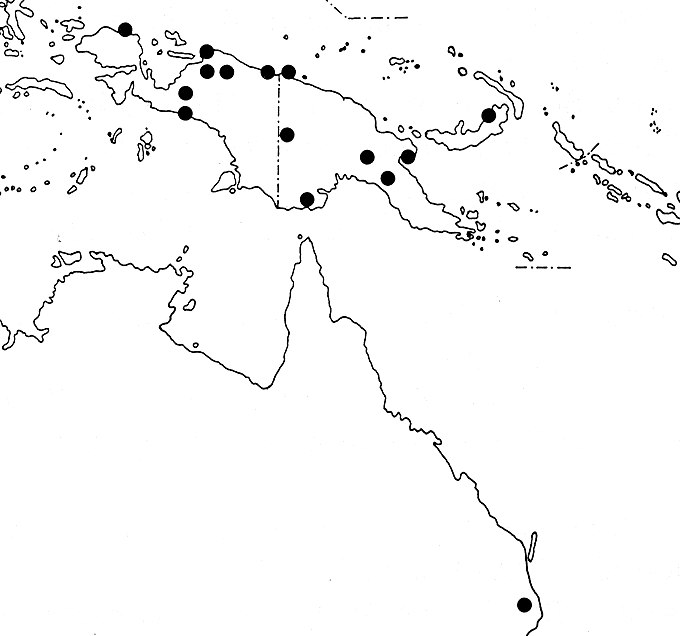
Distribution Map

Description (Barlow 1992)
Loranthus plicatulus Krause, Nova Guinea 14 (1923) 102. -Amyema plicatula (Krause) Danser, Bull. Jard. Bot. Buitenzorg III, 10 (1929) 298. - Amyema scandens subsp. plicatula (Krause) Barlow, Austral. J. Bot. 22 (1974) 588. - Type: Lam 641 (holo L; iso K, U), New Guinea, Mamberamo R., Pionierbivak, 70 m, 16.vii.1920.
Amyema obovata Danser, Bull. Jard. Bot. Buitenzorg III,
11 (1931) 340. - Type: Lam 591 (holo BO, not seen; iso
L), New Guinea, Otke R., near Pionierbivak, 70 m, 8.vii.1920.
Amyema ovariosa Danser, Bull. Jard. Bot. Buitenzorg III,
11 (1931) 340. - Type: Docters van Leeuwen 9383 [lecto
L, fide Barlow, Austral. J. Bot. 22 (1974) 586], New Guinea,
Pionier bivak, 50 m, vi.1926.
Amyema cephalanthera Danser, Brittonia 2 (1936) 131. -
Type: Brass 6023 (holo L), New Guinea,western, Oriomo R.,
Wuroi, 30 m, i-iii.1934.
Amyema pentactis Danser, Blumea 3 (1940) 397. - Type: Clemens
8307a (holo B, not extant, photograph seen, see below), New
Guinea, Morobe, Sattelberg, Abe, 5000-6000 ft (1500-1800 m), 15-18.vi.1938.
Amyema duurenii Barlow, Proc. Roy. Soc. Qd. 75 (1964) 13.
- Type: van Duuren s.n. (holo BRI), New Guinea, Papua,
Kairuku, Ukua Estate, ii.1963.
Amyema angularis Barlow, Austral. J. Bot. 22 (1974)
565. - Type: Eyma 5387 (holo L 952,990-86), New Guinea,
Wissel Lake region near biv. Digatara Pass, 1.xi.1939.
Glabrous or rarely the inflorescence and flowers shortly and sparsely
brown- or white-tomentose. Stems usually robust and distinctly
lenticellate, enlarged at the nodes, angular or terete when young
but terete when older. Leaves opposite, ternate, scattered-ternate,
or rarely quaternate; lamina elliptic to ovate or obovate, or
rarely almost orbicular, (4-)7-13(-16) cm long, (2.5-)5-8(-10)
cm wide, thinly to thickly coriaceous, dull on both sides, cuneate
or attenuate at the base into a petiole (3-) 5-15 mm long, often
undulate at the margin, mostly rounded or rarely broadly acute
at the apex; venation pennate, obscure to distinct with the midrib
usually raised below. Inflorescences several at the nodes;
peduncle (5-)12-25 mm long, 1-2 mm thick; rays 4-6(-8), (4-)6-10
mm long; flowers all sessile in the triads; bracts triangular,
1-2 mm long, broadly acute, forming a small spreading involucre
below the triads. Ovary funnel- to barrel-shaped, 2-3 nim
long; calyx limb truncate or weakly lobed, 0.5-1 mm long, erect.
Corolla in the mature bud slender, (16-)20-28 mm long,
usually rounded or obtuse, 5- or 6-merous. Anther c. 2
mm long, about one fourth as long as the free part of the filament.
Stigma knob-like, about 1.5 times wider than the style.
Fruit ellipsoid to obovoid, 7-10 mm long, crowned by the
calyx limb and often by long persistent styles.
Amyema plicatula is recorded from New Guinea, New Britain,
and eastern Australia (fig. 12; 19 collections seen), mostly at
low elevations but ranging to 2400 m. The species occurs in primary
and secondary rain forest, probably parasitic on a wide range
of hosts including Calophyllum, Discocalyx, Dysoxylum, Galbulimina,
Maniltoa, and Pasania.
Amyema plicatula is a member of the
Amyema scandens species complex which can be identified
in the Papuasian region by the inflorescence of a 4- to 8-rayed
umbel of triads with all flowers closely sessile in an equidistant
arrangement. Within this group it can be identified by its leaves
which are mostly opposite, ternate, or scattered ternate, petiolate,
mostly undulate at the margin and rounded at the apex. The corolla
is described as pink or red.
The two species accepted here as A. caudiciflora and A.
plicatula essentially represent a change of rank for two subspecies
of A. scandens circumscribed by Barlow (1974). Three subspecies
were then recognized within A. scandens, differing in phyllotaxy
and leaf and petiole characters, and apparently having different
areas. These subspecies were circumscribed relatively narrowly,
and many other specimens were treated as a residue of intergrades
within A. scandens. Re-examination of the variation patterns
in the present study has confirmed the existence of three modal
morphological types, but has also shown that virtually all of
the specimens formerly placed in the residue group can be referred
to one or another of these three entities, and that each of these
still has a strong ecogeographic integrity. These more broadly
circumscribed entities appear to retain considerable morphological
integrity in a complex situation of altitudinal zonation and area
disjunction, and it is concluded that they are more appropriately
accorded specific status. Amyema plicatula represents the
entity formerly treated by me as A. scandens subsp. plicatula.
A more critical study of the variation
patterns in the A. scandens complex has shown that some
local New Guinean forms previously accorded specific status, each
based only on a single collection, are part of the continuum of
variation in A. plicatula and, accordingly, are treated
as conspecific. Amyema angularis was formerly distinguished
as a form with small leaves and triangular young stems. Amyema
obovata was formerly distinguished, with some doubt, on the
basis of its opposite thin leaves and slender inflorescences and
flowers. Amyema pentactis was formerly distinguished on
the basis of its opposite, thick, broadly elliptic to nearly orbicular
leaves.
The recent discovery of a population indistinguishable from A.
plicatula in remnant subtropical rain forest in northern New
South Wales represents a striking apparent disjunction of 2400
km in the species range. The alternatives that the population
represents either recent arrival as a waif by distance dispersal,
or a relict of a former continuous range, seem equally unlikely.
Although the Loranthaceae of eastern Australian humid forests
are relatively well known, it is possible that other populations
will be found in the intervening area.
The type of A. pentactis, Clemens 8307a (B), is not extant,
and there are apparently no duplicates. However, a clear photograph
accompanies Danser's description., There is also a specimen Clemens
8307 in L, which agrees closely with the original description
and photograph and has identical label information as the type,
and which may therefore be from the same gathering.
For further discussion, see under A. scandens.
Type.-West Irian, Wissel Lake region near biv. Digatara Pass, Eyma 5387, l.xi.1939 (L 95299086, holotype).
Glaber. Rami juveniles infra nodum triangulares, vetustiores lenticellis orbicu-lares pustulati. Folia displicatae-ternatae; lamina ovata vel spathulata, 25-4 cm longa, 1.5-2 5 cm lata, apice rotundata, margine minute recurvata, basi in petiolum 3 mm longum abrupte attenuata; nervatione obscura. Inflorescentiae in axillis paucae vel plures ortae, pedunculatae, umbellatae; umbellae 4- vel 6-radiatae; radiis apice triflorus, fibres omnes sessiles; pedunculus 12-20 mm longus; radii 6-10 mm longae; bracteae acutae, 1-1 5 mm longae. Calyx infundibuliformis vel cupiformis, 25 mm longus; limbus breve dentatus, 05 mm longus. Corolla in alabastro 5-merus, gracilis, ignota ubi matura.
Glabrous. Young stems triangular below the nodes, distinctly pustulate
with orbicular lenticels when older. Leaves scattered-ternate;
petiole 3 mm long; lamina elliptical to obovate, 2.5-4 by 1.5-2.5
cm, abruptly attenuate at the base, minutely recurved at the margin,
rounded at the apex; venation obscure. Inflorescences few to several
in the axils; peduncle 12-20 mm long; rays 4-6, 6-10 mm long;
all flowers of the triads sessile; bracts acute, 1-1.5 mm long,
forming an open cup below each triad. Calyx funnel- to barrel-shaped,
constricted near the apex, 2.5 mm long; limb shortly toothed,
05 mm long. Corolla in bud 5-merous, slender, not seen mature.
(Fig. 5, a, b.)
Occurrence. Wissel Lake Region, West Irian (Fig. 2).
Specimens Examined. WEST IRIAN: Wissel Lake Region near biv. Digatara Pass, Eyma 5387, l.xi.1939 (L).
Amyema angulare is
related to, and probably a segregate of the Amyema scandens
complex. It is distinct from A. scandens and related
species in the angular stems and small leaves. See note under
A. scandens.
Illustrations
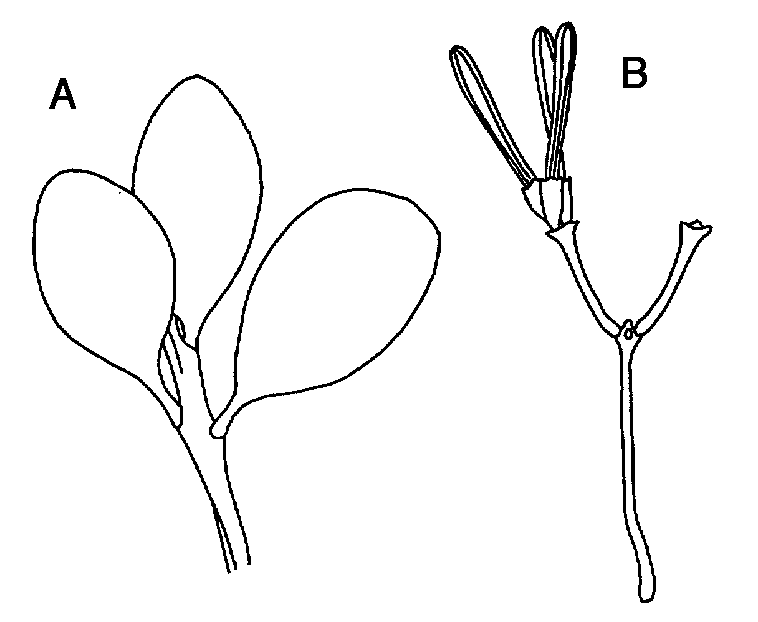
Amyema angulare. A - portion of plant. B - portion of inflorescence. From Barlow (1974).
Description (Barlow 1974) of Amyema obovatum Dans. Bull. Jard. bot. Buitenz. 11: 340 (1931). Type.-Otke R. near Pioneerbivak, 70 m alt., Lam 591, 8.vii.1920 (B, holotype, not seen, probably destroyed; L 926134911).
Glabrous except for the infiorescence and flowers very shortly and sparsely tomentose. Stems slender. Leaves opposite; petiole slender, terete, 5-8 mm long; lamina obovate, 5-7 by 4-6 cm, thin, attentuate at the base, undulate at the margin, rounded at the apex; venation pennate. Inflorescences only seen detached; peduncle 20 mm long; rays c. 5-7 mm long; all flowers of the triads sessile; bracts 1-1.5 mm long, acute or obtuse, shortly united at the margins into an involucre below the triad. Calyx cylindrical to funnel-shaped; limb erect, truncate, c. 1 mm long. Corolla in the mature bud cylindrical, 27-28 mm long, 6-merous. Anthers 2 mm long; free parts of the filaments 8 mm long. (Corolla and anther description from Danser, Bull. Jard. bot. Buitenz. 11: 340, 1931.) (Fig. 5, o, p.)
Occurrence. Mamberamo R., West Irian (Fig. 6), 70 m altitude.
Specimen Examined. WEST IRIAN: Otke R. near Pioneerbivak, 70 malt., Lam 591, 8.viii.1920 (L).
See note under A. scandens.
Illustrations
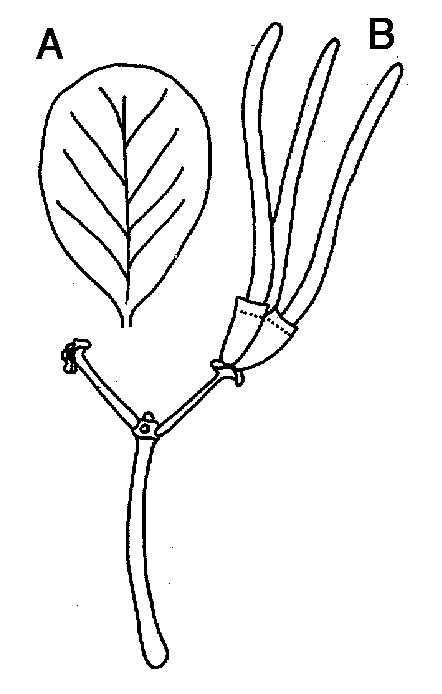
Amyema obovataum. A - leaf lamina. B - portion of inflorescence. From Barlow (1974).
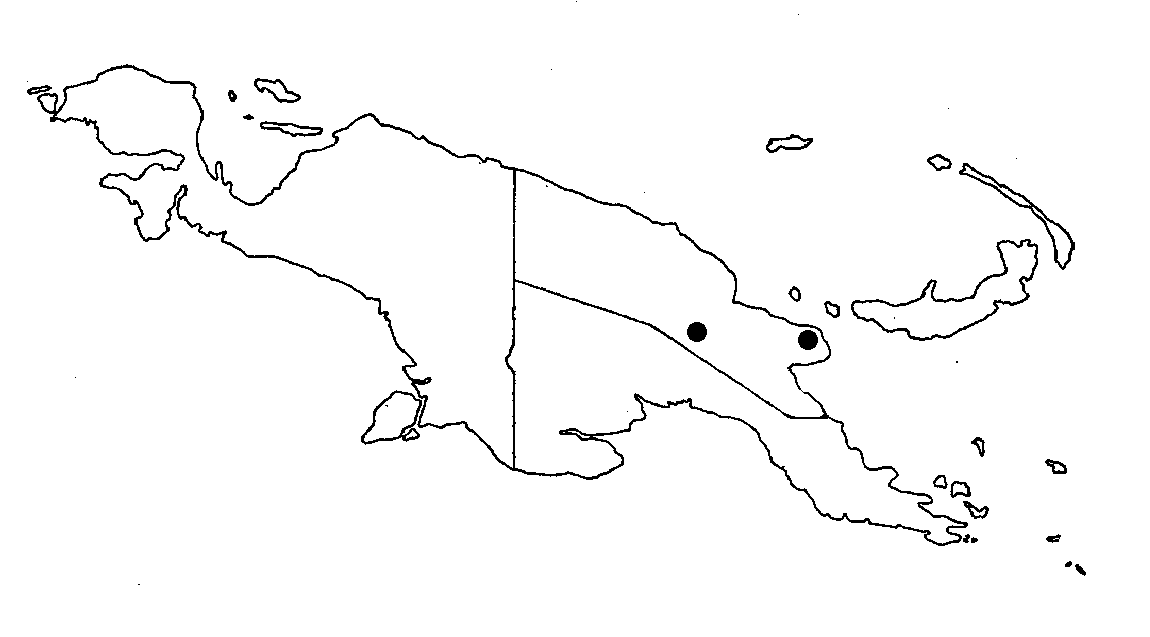
Description of Amyema pentactis Dans. Blumea 3: 397 (1940). Type-New Guinea, Morobe Dist., Mt. Sarawaket, Abe, 1500-1800 m alt., Clemens 8307a, 15-18 June 1938 (B, not seen, probably destroyed, but a clear photograph accompanies Danser's description).
Glabrous. Stems terete, enlarged at the nodes, distinctly lenticellate. Leaves scattered-ternate; petiole distinct, 0.3-0.5 cm long; lamina broadly elliptical (to orbicular), 4-8 by 3-5 cm, contracted, truncate or rounded at the base, narrowly marginate, rounded at the apex; venation pennate, obscure. Inflorescences several at the nodes; peduncle robust, 18-25 mm long, 2 mm thick, slightly dilated at the apex; rays 5-8, almost as thick as the peduncle, 4-9 mm long; flowers all sessile in the triads; bracts triangular, 2 mm long, not united at the margins. Calyx barrel-shaped; limb erect, irregularly lobed or split in the upper 05 mm, 1 mm long. Corolla in the mature bud cylindrical, obtuse at the apex, 16-19 mm long, 6-merous. Anthers 2 mm long; free parts of filaments 8 mm long. Fruit not seen.
Occurrence. New Guinea, in the Finisterre Mountains and Eastern Highlands (Fig. 6), 1500-2400 m altitude.
Specimen Examined. EASTERN NEW GUINEA: Eastern Highlands, Asaro-Mairi divide near Daub Camp, c. 2240 m alt., Hoogland and Pullen 5433, 23.vii.1956 (CANB 61857; L 957197895).
The specimen cited above is markedly distinct from all other material of Amyema examined in the present study. In most essential characters, however, it appears to agree with Danser's description of A. pentactis and with the photograph which accompanies that description. The holotype of A. pentactis has presumably been destroyed. I would therefore prefer to treat the collection cited above as belonging to A. pentactis rather than to describe it as a new species.
The Clemens collection appears to be slightly larger in vegetative
parts than the Hoogland and Pullen collection. Danser described
the Clemens collection as having opposite leaves, whereas the
Hoogland and Pullen materials clearly have scattered-ternate leaves.
Close examination of the photograph of the type indicates that
the leaves may in fact have an irregular scattered-ternate
arrangement.
See note under Amyemascandens.
Photographs
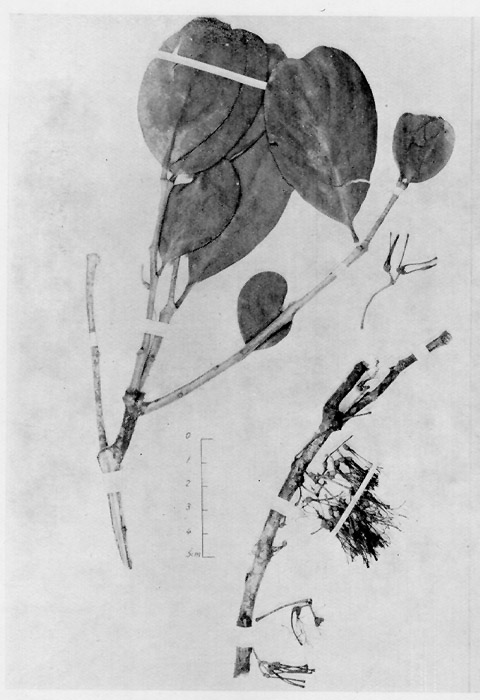
Amyema pentactis. Photograph of part of the type (Clemens 8307a). From Danser (1940).
Amyema plicatula
updated 18 January 2007